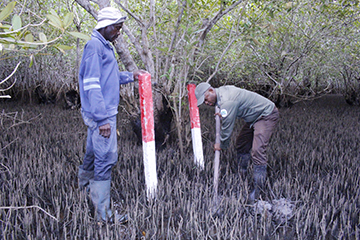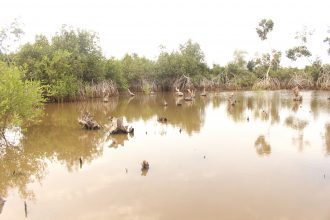SDM Project: Mangrove restoration to improve socioecological production landscapes and seascapes for fisheries recovery at the Muni Pomadze Ramsar Site
25.12.2017
SUBMITTED ORGANISATION
A Rocha Ghana. Ghana
PARTNER ORGANISATIONS
Wildlife Division of Forestry Commission
DATE OF SUBMISSION
25/12/2017
REGION
Africa
COUNTRY
Ghana
FOCAL POINT
Jacqueline Sapoama Mbawine (Fundraiser)
SDM website
More information is available here
Abstract
The fisheries sector of Ghana plays an important role in contributing significantly to national economic development objectives related to employment, livelihood support, poverty reduction, food security, foreign exchange earnings and resource sustainability (MOFA, 2016). The Effutu Municipality is one of the vibrant fishing hubs in the Central region of Ghana. The Muni Pomadze Ramsar site is a key coastal resource within the Effutu Municipality supporting both community livelihoods and sustaining the ecological integrity of the site which serves as habitat for both terrestrial and aquatic biodiversity. However due to increase degradation to the site, biodiversity is under threat and communities are losing their source of livelihood as fisherfolks. This project therefore aims to empower coastal communities within the Effutu Area to sustainably manage their own marine resources, resulting in productive and profitable fisheries, coastal ecosystem conservation and/or resilience to climate change. The objectives of the project are to 1. Undertake behaviour change communication on sustainable coastal resource management for improved SEPLS. 2. Initiate improvement actions to enhance sustainable coastal resource management. As part of the project over 800 community members were sensitized in engaged in various awareness creation programmes using platforms such as radio, community durbars and one-to-one engagements. 6000 red mangrove seedlings were nursed and replanted on 5ha of degraded mangrove areas, communities were supported to demarcate a fisheries recovery zone, by erecting pillar over an agreed are demarcated as core zone and a buffer zone. To ensure community cohesion on conservation action, a volunteer group was established and mandated to monitor illegal activities within the community demarcated area. They would also serve as advocates to enhance community engagement on sustainable coastal resource management. Waste bin were also supplied and placed at designated points within the community to curb the challenge of poor waste management within the site. The project has contributed to IPSI strategic objective 1 and 2, Aichi target 1, 5, 6 and 15 and SDG 12 and 13. The most important achievement of this project is the demarcation of a fisheries recovery zone which would serve as a mean of enhancing both fisheries recruitment as well as protecting the habitat of aquatic species.



